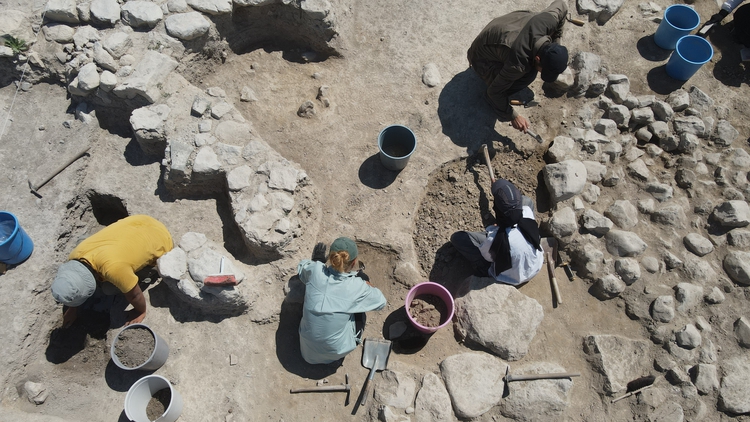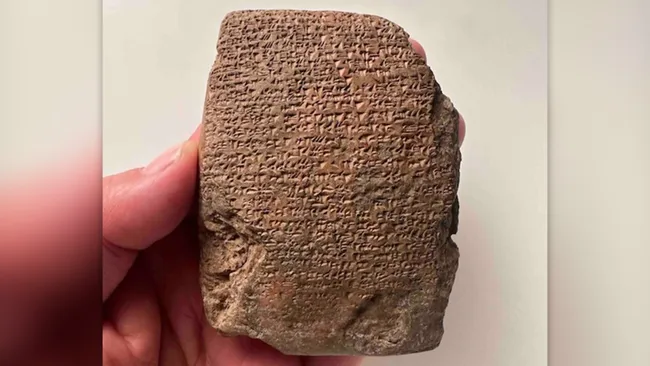
3500-year-old Hittite mudbrick structures at Porsuk-Zeyve Höyük emerged stronger from the fires
The Hittite mudbrick structures at Porsuk-Zeyve Höyük, which was an important settlement in the Bronze Age due to its location on the road connecting Central Anatolia to the Mediterranean, have survived to the present day, strengthened by fires thought to have started in the 15th and 16th centuries BC. Porsuk-Zeyve Höyük is located near the

Excavations started at Oylum Höyük, one of the largest mounds in the Middle East
The 2024 excavation season has begun at Oylum Höyük (Oylum Mound), one of the largest mounds in the Middle East, located in Kilis province in southeastern Türkiye. The mound is 460 meters long and 370 meters wide, consisting of two elevations, one 22 meters and the other 37 meters, with a dominant position over the

Surprising discovery in the ‘holy water’ of the Hittites
Ongoing archaeological excavations in the sacred Hittite city of Nerik (today’s Oymaağaç Mound) are revealing surprising discoveries. With a 3500-year history, Nerik, which is considered a sacred city by the Hittites, is located 7 kilometers northwest of Vezirköprü district of Samsun. Nerik was founded by the Hattis and after the fall of the Hittite empire,

Using 3,500-year-old tablets, bread from the Hittite, Sumerian and Roman periods was baked
Bread is an indispensable food source in every period of history. In Anatolia, home to the transition to settled life, bread is considered both a foodstuff and a sacred food offered to the gods. The Hittites are a Bronze Age civilization that stands out with its bread making and diversity. Hundreds of tablets unearthed in

Excavations have started at the Kültepe ruins where the oldest written documents in Anatolia were found
The 76th year of excavations at Kültepe, an important karum in Anatolia during the Assyrian trade colonies, has begun. Kültepe is about 24 km from Kayseri city center. It functioned as an important trade center of the Assyrians and Hittites from 2000 BC to 1200 BC. The most important feature of Kültepe is that the

Approximately 2 thousand cuneiform tablets from the Hittite period read by artificial intelligence
With the project, which is a first in the world, thousands of years old Hittite tablets are read by artificial intelligence. Gökhan Yazgı, Deputy Minister of Culture and Tourism, said: “So far, we have scanned and completed nearly 2 thousand tablets, and we have ensured their reading. We have taken a big step in accessing

The Hittites’ famous gold-hilted iron dagger was forged from iron with extraterrestrial origins
The Hittites, the biggest player on the Anatolian civilization stage, were also a pioneering society in the processing and use of iron. The gold-hilted iron dagger found during the excavations at Alacahöyük was the best example of Hittite ironworking. The dagger is also an important discovery because it is a dagger forged from iron with

Aygül Süel “We are making big mistakes about the Hittites”
Prof. Dr. Aygül Süel, Head of the Department of Archaeology, Faculty of Arts and Sciences, Hitit University and the director of the excavation of the city of Sapinuwa , said in an online session she attended in recent years that we are making great mistakes for the Hittites. Stating that some of the information that has

A 3,300-year-old tablet found at Büklükale tells of a catastrophic foreign invasion of the Hittite Empire
The Hittite Empire, considered to be the first centralized state of Anatolia, began to rise around 1600 BC and formed a strong political and military union. After ruling for nearly 400 years, the empire suddenly collapsed around 1200 BC. This sudden collapse has remained a mystery that has been investigated by historians and archaeologists for

In the Hattusa excavations, a decoration piece made of 2,800-year-old elephant ivory was discovered
A decoration piece made of 2,800-year-old ivory was found during the ongoing excavations in Hattusa (today Boğazköy), the capital of the Hittites, who established the first central state organization in Anatolia. The discovered elephant ivory decoration piece is approximately 30 centimeters in length and 10 centimeters in width. It features a sphinx (a sculpture with
